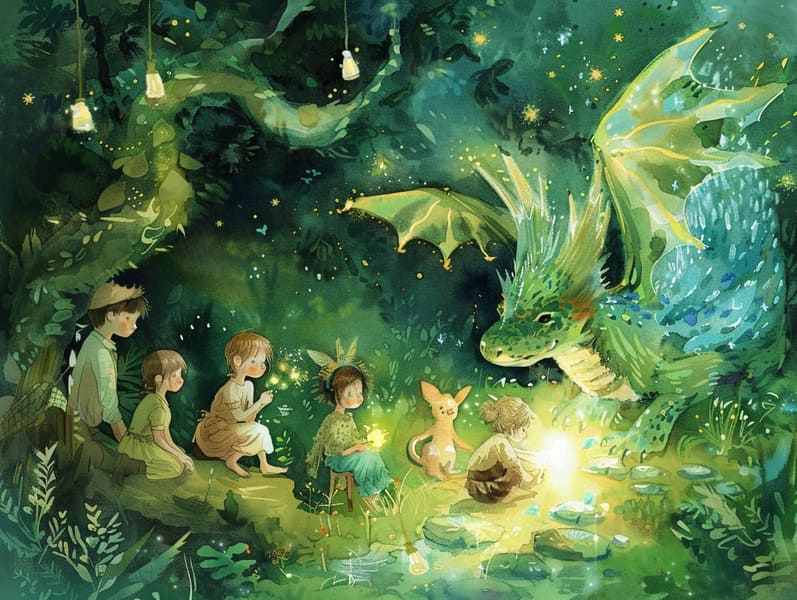The Dawn of Fairy Tales for Kids and Their Steadfast Grace.
The Dawn of Fairy Tales for Kids and Their Steadfast Grace.
Blog Article

Fairy tales for kids have timeless appeal. These stories have been relayed from one generation to the next well before they were ever published. They arose from a variety of backgrounds, including Middle Eastern traditions. They were initially narrated among adults, often carrying themes and messages reflective of the societal norms and beliefs of the time.
Jacob and Wilhelm Grimm, Jacob and Wilhelm (the Grimm brothers), were among the first to compile and publish many of these beloved narratives. Their published works, "Grimm's Fables," included narratives like "Cinderella," "The Story of Hansel and Gretel," and "Snow White," which have since become cornerstones in the world of classic fairy tales. Similarly, Hans Christian Andersen's enchanting narratives, such as "The Sea Maid," and "The Story of the Ugly Duckling," have floated into hearts worldwide, solidifying their place in the pantheon of iconic fairy tales.
Though they are centuries old, these stories remain as pertinent as ever, especially as kids' bedtime tales. These delightful tales are now available in numerous formats, including artistically illustrated books, charming animations, and online fairy tales.
Their ongoing significance can be credited to several fascinating points:
Important Morals: Traditional fairy tales often offer important moral lessons. Narratives like "The Wolf and the Liar" teach the value of truthfulness, while "The Tale of the Tortoise and the Hare" point out the merits of resolve and humility. These narratives offer children clear distinctions between virtue and vice, guiding their moral compass in a soft yet deep way.
Empathy and Understanding: Traditional fairy tales frequently feature individuals facing trials and tribulations, inspiring young listeners to sympathize with their struggles and champion their triumphs. For instance, "The Story of Beauty and the Beast" emphasizes the importance of valuing inner qualities to appreciate the real person of a person, strengthening kindness and recognition.
Cultural Comprehension: Many ancient fairy tales are deeply embedded in the cultural contexts from which they sprang. Delving into these tales can provide captivating looks into different cultures, nurturing a sense of cultural insight and discernment.
Creativity and Fantasy: The enchanted elements in traditional fairy tales—mythical entities—generate children’s inventiveness. These fairy tales take readers to mythical realms, triggering imaginative ideas and a sense of awe that endures a lifetime.
Ancient fairy tales are not only bewitching but also teaching. They work as entrancing tools in cultivating various mind and heart abilities in little ones. When ancient fairy tales are recited, they enhance verbal skills by showing new terms and meanings and elaborate sentence structures. This practice also fosters listening original fairy tales for bedtime skills and mental focus, as little ones follow the story, expectant to see what happens next.
Furthermore, discussing the themes and characters of old fairy tales can foster reasoning skills and reasoning skills. The young are educated to notice patterns, expect results, and comprehend cause and effect. These conversations also contribute to children reveal their thoughts and feelings, boosting their emotional intelligence.
In today’s information age, the abundance of web-based fairy tales has made these stories more accessible than ever. Web platforms and online apps offer comprehensive collections of famous fairy tales that can be viewed or listened to anytime, anywhere. Fairy tales told out loud are particularly liked, offering an charming way for little ones to immerse in these magical stories. Read-aloud books and read-aloud videos bring characters and settings to life, often supplemented by fantastical harmonies and instrumentals that improve the storytelling experience.
The enduring charm of traditional fairy tales lies in their ability to transform to modern times while staying true to their key morals. Contemporary adaptations of these tales often incorporate more inclusive figures and modern settings, making them relevant to today’s audience. However, the fundamental themes of valor, benevolence, and integrity remain unchanged, continuing to touch children of all ages.
Old fairy tales also offer a sense of warmth and knownness. They supply a ordered narrative with a evident beginning, middle, and end, often concluding with the culmination of conflicts and the triumph of rightness over wrongness. This regularity can be solacing for little ones, gifting a sense of steadfastness in an variable world.
Traditional fairy tales continue to delight and coach new generations, maintaining their wonder and relevance in modern society. As nighttime stories for kids, they put forth a perfect blend of captivation and insight, advancing moral values, empathy, and creativity. The existence of internet fairy tales and the commonness of fairy tales told out loud certify that these ancient fairy tales remain within reach to new generations.
By continuing and disseminating these fairy tales, we continue to admire the rich tapestry of folklore and cultural heritage. Whether you are accessing a vibrantly illustrated book, exploring a electronic library, or listening to an read-aloud story, the captivation of old fairy tales is always within reach. These stories convey of the persistent presence of tales and its ability to bond us across time and space.
Even if you are discovering a colorful picture book, delving into a electronic library, or listening via an narrated book, the splendor of Grimm's fairy tales is always within reach.
These narratives remind us of the ageless strength of fairy tales and its ability to bond us across eras and regions, forming a connection that captivates and teaches alike.